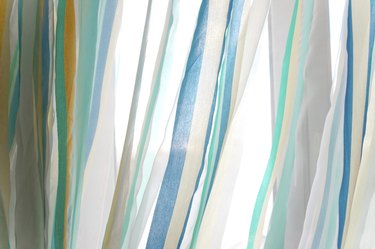
Tulle is a net-like transparent fabric that is commonly used to decorate weddings. The fabric is used for overhead canopies, centerpieces, chair decorations, pew decorations, favors, table decor and more. Small decorations, such as gemstones or paper-thin flowers, can add to the overall effect. They can be attached with fabric glue or a hot glue gun.
Tulle
Video of the Day
Tulle is sold in a wide variety of colors and size of netting. Some tulle is already embellished with sparkly elements, glitter or small items. The thicker the tulle is, the easier it will be for the material to hold items or to be glued to itself. When selecting tulle for your event, purchase practice swatches and test out your glues and items to be glued to see how well they hold up. Your choice should also depend on how much movement or strain will be put on the glue during the event.
Video of the Day
Rhinestones
Rhinestones are flat-backed, mirrored and faceted glass that are designed to be attached to fabric, paper or other surfaces. The rhinestone has mirror paint that creates the shiny reflection. The mirror paint will separate from the glass part of the rhinestone fairly easily. When gluing rhinestones, use enough glue to cover the back and the sides of the rhinestone so that the glue actually adheres to the glass surface and not just the mirror paint. Because tulle is porous, the fabric may need to be stretched on a hoop so that as the stone dries it doesn't attach to anything under the fabric at the same time. Use a rhinestone-to-fabric glue for gluing rhinestones.
Quick Grab Glues
Test out clear quick grab glues for gluing other objects onto tulle. Quick grab glues are clear and sold in small tubes. The label will indicated the glue is fast-acting and what surfaces it can be used on. Apply the glue in small drops to one or both surfaces being glued. Again, it is probably necessary to elevate the fabric so that the glue doesn't attach to anything on the back side of the tulle. You can place the fabric over a clothes drying rack to keep the glue from touching anything but the object you are attaching. Try to keep your flowers, ribbons, butterflies, angels or other small objects very light in weight if your tulle is thin.
Hot Glue
The easiest way to glue tulle to itself is by using a hot glue gun. Hold the tulle open and add glue, folding the tulle onto the glue in layers if you are gathering a large group of tulle together. Hold the tulle in your hand for five minutes to allow the glue to dry completely so that it doesn't pick up other things while the glue is wet. When possible, compress the tulle during the drying process to gain as much surface for the glue to stick to as possible.
Tips
Use smaller spots of glue on small stones and larger spots on large stones. With time, you will become more adept at eyeing how much glue is needed for each. Let the rhinestone glue begin to clear before moving on to the next stone. With practice, you should be able to set about 10 stones per hour. Also, if a hot glue gun in not available, use the waxy end of an applicator stick to apply the glue. Allow 24 hours for the glue to dry before wearing the garment, if possible. And never dry clean the garment; hand wash it in cold to warm water only.